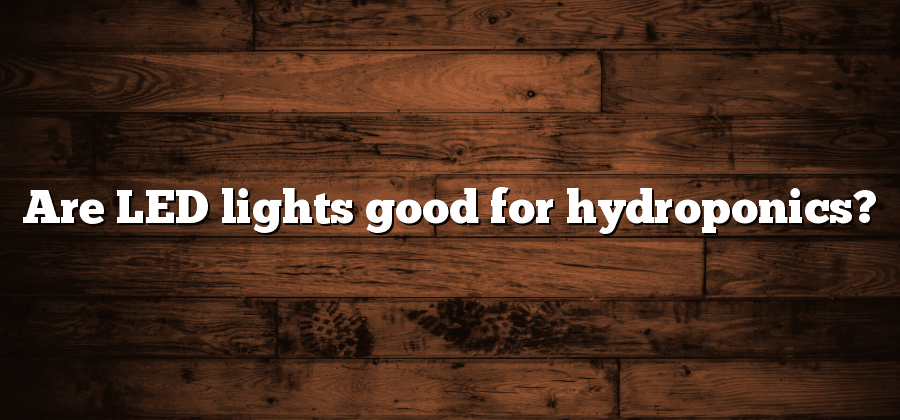Benefits of Using LED Lights in Hydroponics
LED lights have revolutionized the world of hydroponics by offering numerous benefits to growers. One of the key advantages is their energy efficiency. LED lights use significantly less energy compared to traditional lighting systems, making them cost-effective and environmentally friendly. This not only helps reduce electricity bills but also contributes to sustainable agriculture practices.
Another notable benefit of using LED lights in hydroponics is the ability to provide an optimal light spectrum for plant growth. LED lights can be customized to emit specific wavelengths of light that are essential for photosynthesis and plant development. This ensures that plants receive the right amount and type of light they need at different stages of growth, leading to healthier and faster growth rates. Additionally, LED lights can be adjusted to provide the right intensity and duration of light, allowing growers to mimic natural sunlight and optimize the growing conditions for their crops.
Energy Efficiency of LED Lights
LED lights have become increasingly popular in hydroponics due to their remarkable energy efficiency. Compared to traditional light sources such as incandescent or fluorescent bulbs, LED lights have a significantly lower energy consumption. This means that not only do LED lights help reduce electricity costs, but they also contribute to a more sustainable and eco-friendly approach to hydroponic farming.
The energy efficiency of LED lights is attributed to their ability to convert a higher percentage of electrical energy into usable light. Unlike other types of lights that produce a large amount of heat, LED lights emit light in a specific wavelength range, eliminating the need for energy to be wasted on heat generation. This focused light output not only provides plants with the exact spectrum they need for optimal growth but also ensures that less energy is lost in the form of heat, making LED lights a highly efficient choice for hydroponic systems.
Optimal Light Spectrum for Hydroponic Growth
One crucial aspect of achieving optimal growth in hydroponics is providing the plants with the right light spectrum. Each stage of plant growth requires different wavelengths of light to stimulate specific physiological processes. By selecting the appropriate light spectrum, hydroponic growers can effectively boost the development and overall health of their plants.
The ideal light spectrum for hydroponic growth consists of a combination of blue and red light wavelengths. Blue light, which falls within the 400 to 500 nanometer range, is essential for promoting vegetative growth, strong root development, and foliage expansion. On the other hand, red light, ranging from 600 to 700 nanometers, is crucial during the flowering and fruiting stages, as it stimulates the synthesis of chlorophyll and enhances blossom formation. By providing the plants with the correct balance of blue and red light, hydroponic systems can effectively replicate and optimize natural growing conditions, resulting in healthier and more productive crops.
Enhanced Growth Rates with LED Lights
The use of LED lights in hydroponics has shown significant potential in enhancing growth rates of plants. This is primarily due to the specific light spectrum that LED lights emit, which can be fine-tuned to meet the specific needs of different plant varieties. LED lights can provide the necessary wavelengths of light that plants require for optimal photosynthesis, resulting in increased rates of growth and development.
Furthermore, LED lights are highly energy-efficient, consuming significantly less electricity compared to traditional lighting systems. This means that growers can save on energy costs while still achieving impressive growth rates with LED lights. Moreover, the cool operating temperature of LED lights reduces the risk of heat damage to plants, allowing them to thrive without the risk of wilting or burning.
In conclusion, the use of LED lights in hydroponics offers immense benefits in terms of enhancing growth rates. From providing the ideal light spectrum for photosynthesis to being energy-efficient and safe for plants, LED lights have revolutionized the way we cultivate crops. With their ability to promote accelerated growth and development, it is no surprise that an increasing number of hydroponic growers are making the switch to LED lights for achieving maximum yields and superior crop quality.
Increased Yield and Crop Quality
Improving the yield and quality of crops is a primary concern for hydroponic growers. LED lights have emerged as a popular choice in this regard due to their ability to stimulate plant growth and enhance overall crop quality. The focused light emitted by LED lights ensures that plants receive the optimal amount of light they require for photosynthesis, resulting in increased productivity. Unlike traditional lighting systems, LED lights can be adjusted to emit specific wavelengths of light, allowing growers to cater to the unique needs of different plants at different stages of growth. This targeted light spectrum not only accelerates plant growth but also promotes the development of larger and healthier crops.
LED lights have also been found to play a crucial role in improving the quality of hydroponic crops. By providing the right balance of light and heat, LED lights encourage the production of desirable traits in plants, such as enhanced flavor, color, and nutrient content. Additionally, the controlled environment created by LED lighting systems reduces the risk of pest and disease infestations, further safeguarding crop quality. By harnessing the capabilities of LED lights, hydroponic growers can consistently achieve higher yields and ensure that their crops meet the stringent standards of taste, appearance, and nutritional value demanded by consumers in today’s market.






